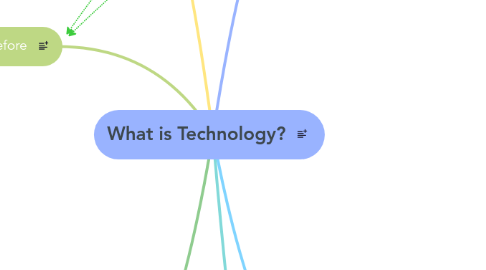
1. why we need new technologies
1.1. "Technology,It's increasing choices, opportunities, possibilities. And freedoms"(Kevin Kelly's)
1.2. Technology can drive human civilization forward. Without technology, humans cannot progress any further.
1.3. "technology is an extension of life"(Kevin Kelly's)
1.4. "technology and new technology are widely used as the yardsticks for progress"(Slack, J. D., & Wise, J. M. (2005).
2. What I thought before
2.1. Hardware
2.1.1. High-speed train
2.1.2. Electric car
2.1.3. Drone
2.1.4. Space station
2.2. Software
2.2.1. Software operating system
2.2.2. Internet platform
2.2.3. Genetic engineering
2.2.4. Mobile signal network
3. References
3.1. Barley, S. R. (1998). What can we learn from the history of technology? Journal of Engineering and Technology Management, 15(4), 237-255. https://doi.org/10.1016/S0923-4748(98)00016-2 Carroll LSL. A Comprehensive Definition of Technology from an Ethological Perspective. Social Sciences. 2017; 6(4):126. https://doi-org.wv-o-ursus-proxy06.ursus.maine.edu/10.3390/socsci6040126 Defining the word “Technology” . . . four times - John Dyer. (n.d.). https://perma.cc/FV4Q-FNNC Hughes, T. P. (2004). Human-built world: How to think about technology and culture. University of Chicago Press. Heidegger, M. (1977). The question concerning technology. Readings in the Philosophy of Technology, 9-24. Li-Hua, R. (2007), "What is technology?", Journal of Technology Management in China, Vol. 2 No. 3. https://doi-org.library.sheridanc.on.ca/10.1108/jtmc.2007.30202caa.001 Moor, J.H. Why We Need Better Ethics for Emerging Technologies. Ethics Inf Technol 7, 111–119 (2005). https://doi-org.wv-o-ursus-proxy06.ursus.maine.edu/10.1007/s10676-006-0008-0 Slack, J. D., & Wise, J. M. (2005). Culture+ technology: A primer. Peter Lang. TED. (2010, February 22). Kevin Kelly tells technology’s epic story [Video]. YouTube. https://www.youtube.com/watch?v=GS1xL1qcBa4 Young, A. T., & Pearson, G. (Eds.). (2002). Technically speaking: Why all Americans need to know more about technology. National Academies Press.
4. What I learned from course material
4.1. Kevin Kelly's (2010), TED talk: "Technology is anything useful invented by a mind."
4.2. "Technology is messy and complex. It is difficult to define and to understand" (Hughes, T. P. (2004)).
4.2.1. "The word technology usually conjures up many different images and generally refers to what has been described as the “high-tech” or high-technology industries. It has to be understood that limiting technology to high-tech industries such as computers, superconductivity, chips, genetic engineering, robotics, magnetic railway and so on focuses excessive attention on what the media consider newsworthy (Gaynor, 1996). However, limiting technology to science, engineering and mathematics loses sight of other supporting technologies. Technology includes more than machines, processes and inventions. Whereas, traditionally it might refer to hardware, these days it also refers to the “soft side” as well. In fact, there are many manifestations of technology: some are very simple while others are very complex." (Li-Hua, 2007)
4.3. “technology” is not just the phones in our pockets and the laptops in our bags"(Dver. J)
4.3.1. Technology as Hardware – this is the basic level that most of us mean when we use the word “technology.” As a piece of hardware (or an “artifact” for the anthropologist or “cultural good” for the sociologist), “technology” could be a clock, a shovel, a laptop, a belt, a thermometer, a can of root beer, a canteen, a tank, or a fake duck decoy. These are basically things do not occur “naturally” – which, for theists, are things God himself did not make.(Dver. J)
4.4. Technique and knowledge must be organised before they can bring about effective results.(Li-Hua, 2007)
4.4.1. Knowledge consists of three principal categories: applied science, skills, and intuition. The weighting between these categories of knowledge is changing historically, but in every case, an adequate combination of types of knowledge must be present. Knowledge is the “key to control” over technology as a whole, which can be seen both at micro level (Taylorism) and at higher levels of social aggregation (technological dependency). However, it is helpful to understand that knowledge has recently been classified as explicit knowledge and tacit knowledge.(Li-Hua, 2007)
